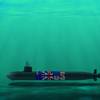Center for Naval Engineering (CNE) Learning Site Great Lakes launched the first phase of Computer-Based Training (CBT) Nov. 28 with the first wave of Basic Engineering Common Core (BECC) students breaking in the new curriculum in an Integrated Learning Environment (ILE).
Cmdr. Eddie Oleykowski, director of training, CNE, Norfolk, Va., supervised as the first class of 25 students officially made the transition from instructor-led training to CBT. In the ILE, the traditional instructor is replaced with a facilitator who addresses individual student concerns along the way.
Oleykowski said the launch of CBT is part of a vision to “re-engineer the BECC curriculum” in line with the Revolution in Training, thus “converting the traditional lock step structure to a state-of-the-art blended learning solution comprised of self-paced, high fidelity Level 2 and 3 interactive computer-based training.”
The Naval Personnel and Training Command introduced the ILE concept in 2002 as part of the Revolution in Training to standardize content and improve access to curriculums. There are 450 computers that have been installed in nine classrooms as part of the ILE at CNE Great Lakes. Each room is equipped with 50 computers. The new online curriculum, which is run through Navy Knowledge Online, contains content from the first four modules of the BECC course. Instructors are still teaching the remaining topics and modules until further CBT implementation.
As the first class of students sat down at their individual workstations to kick off the future of surface engineering training, Seaman Eric Rink, 19, of Pueblo, Colo., commented that the content was “easy to follow.”
”The online curriculum...contains text, access to Navy references and publications, animation, simulations and interactive exercises,” said Officer-in-Charge, CNE Great Lakes, Cmdr. Don Nuckols.
Fireman Recruit Jeffrey White, 18, of Largo, Fla., who had completed the first topic in Module One – "Personnel Qualification Standards" (PQS) – in under an hour with a 100 percent pass rate, said he liked the fact that the course is self paced. “It’s easier for me to learn by reading the material on the computer than by listening to an instructor,” he said.
With CBT, the BECC course is still balanced between theory and lab work, enabling students to immediately put into practice what they have just learned.
BECC Director and Student Support Officer Chief Warrant Officer Scott Johnson said, “For instance, in their first CBT lesson they cover PQS and then Tools and Uses, then following the CBT lesson they go down to the Precision Measuring Lab and practice what they’ve just learned in Tools and Uses, and that’s the general format.”
There are eight modules in BECC. Before each module, students are given a pre-test, and at completion a post-test, allowing facilitators to measure increases in comprehension of the material. Facilitators can also monitor each student’s results and progress in the ILE.
The second phase of CBT implementation is anticipated by February 2006. Oleykowski said that once the BECC curriculum is fully converted to CBT it will become available and eventually accessible fleetwide.
Source: NavNews
By Eva Kowalski, Training Support Center Great Lakes Public Affairs
Subscribe for
Maritime Reporter E-News
Maritime Reporter E-News is the maritime industry's largest circulation and most authoritative ENews Service, delivered to your Email five times per week










